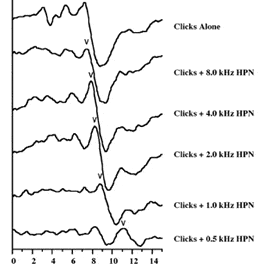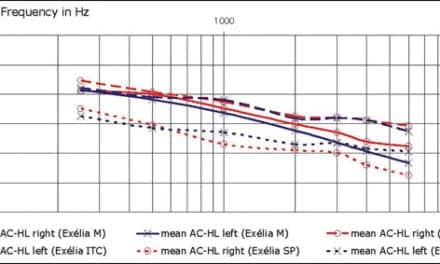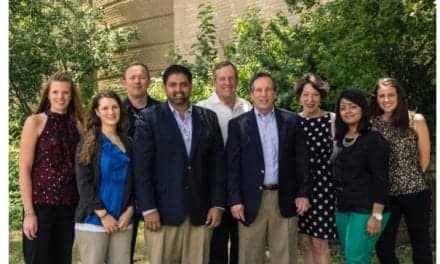The book that I edited in 1980, Binaural Hearing and Amplification,1 was an attempt to bring together the current thoughts and “state of the art” concerning binaural hearing and amplification. The original intent was to publish a short, easy-to-digest, 50-page monograph. It soon became obvious that the task was formidable. The literature was voluminous and complex.
The theoretical concept that binaural hearing for normal-hearing individuals enhances speech intelligibility and facilitates directional hearing was generally accepted then, as it is today. The basic question, however, was not whether two ears are better than one, but rather, “Are two hearing-impaired ears coupled to two hearing aids better than one?” This question has generated a wealth of research and has absorbed a great deal of time and energy. Binaural Hearing and Amplification can be viewed as an early attempt to address this basic question.
We were fortunate in drawing together 45 worldwide experts from diverse disciplines. It would be absurd to claim that this work contained all that might be said about binaural hearing and amplification. It also cannot be denied that—despite an attempt to present a balanced, even-handed approach—that our optimistic view and personal prejudices were apparent.
When our book was introduced to the professions, binaural hearing aids accounted for approximately one quarter (27%) of hearing aid fittings; today, the percentages have almost flip-flopped with four in five (80%) of fittings being binaural (Figure 1).2 We are hopeful that, in some small way, our book was partially responsible for this rise.

|
| Figure 1. The monaural versus binaural revolution: Fitting rates reached the 50%-50% point in 1992, and today binaural hearing aids constitute well over 70% of all hearing aid fittings in the United States.3 |
In the 1970s and early 1980s—a time when audiologists assessed the patient’s hearing and made recommendations, then the dispenser fit the hearing aids—the climate of the audiological community was not exactly favorable to binaural hearing. Berger and Millin3 noted in 1971 that many clinicians apparently suspect that dispensers are often trying to sell binaural hearing aids to double their profits, and the dispenser, in turn, wonders why the clinician can’t appreciate the value of binaural aids, even when the user reports greater satisfaction with them.
The Elusive Binaural Advantage
Three legends in audiology—James Jerger, Raymond Carhart, and Donald Dirks—reported on experiments4,5 they conducted in 1961, and these findings had tremendous influence on some of the early debates about binaural amplification. Perhaps the most quoted conclusion of these early studies was:
“In general, the results failed to demonstrate the marked superiority of binaural amplification … the results climax a series of experiments from this and other laboratories all pointing to the same inevitable conclusion. Binaural amplification produces little or no objectively demonstrable improvement in the ability to understand speech or noise against competing sentences or competing discourse, whether the speech material [is] isolated words or meaningful sentences … in spite of subjective clinical observations of dramatic improvement in the performance of some patients with binaural aids … there remains little concrete evidence that binaural amplification actually produces any significant improvement in the ability to understand speech.”4
We will discuss in more detail these findings in the next section of the article.
Burney’s 1972 survey6 of the hearing aid evaluation procedures of 214 ASHA-certified clinics reported no mention whatsoever of binaural hearing aids, much less any suggestion for a standardized way of testing the effectiveness of binaural hearing aids on an individual. In fact, most of the texts of the 1960s and 1970s treated the subject in cursory fashion.
The final 1978 report to the Federal Trade Commission (FTC) by the Bureau of Consumer Protection states:
“Binaural amplification is generally considered appropriate only for people with a relatively symmetrical hearing loss, although some industry representatives dispute the point. Manufacturers and dispensers are understandingly enthusiastic supporters of binaural amplification, since it means the sale of two hearing aids rather than one. Audiologists are less enthusiastic, principally, because of the dearth of clinical evidence of binaural superiority. The advantages cited for binaural amplification include improved localization ability, better speech discrimination ability, greater ease of listening and better sound quality. These advantages are essentially subjective and therefore can not be demonstrated with existing clinical techniques.”7
The above is meant only as some background on the ideas of the day, as well as to demonstrate the need to publish a book that brought forth the potential merits of binaural hearing aids. It should be noted that, without the benefit of 20-20 hindsight, the laboratory evidence did appear to rule against binaural amplification in many or most cases of hearing loss, even though clinical experience indicated otherwise.
Unfortunately, there was fingerpointing by some clinical audiologists during these binaural-versus-monaural debates that impugned the integrity of hearing instrument dispensers. As fate would have it, the US Supreme Court came to the rescue. In 1978, a Supreme Court ruling in an indirectly related case forced ASHA to lift its ban on hearing aid dispensing. Following this decision, many members of ASHA who had previously been critical of binaural amplification became dispensing audiologists—and miraculously discovered the binaural advantage on their own.
Some Practical and Scientific Considerations
The task of demonstrating a “significant advantage” for a binaural versus monaural fitting is often more complex than showing improved speech discrimination for a group of subjects. Unfortunately, a lot of effort was devoted to determining the influence of electroacoustic characteristics of hearing aids on speech discrimination rather than determining whether this was actually the most important question (or even if it was an important question for the population under study).8 As Barfod9 clearly stated in the 1970s: “A hearing aid is a personal prosthesis; thus, the criteria for deciding whether one hearing aid characteristic is superior to another can only reasonably be chosen by the patient himself.”9
Results of the early investigations were questioned. In 1977, Ross10 observed that the results of the Jerger, Carhart, and Dirks study4 did not warrant the sweeping conclusions that binaural amplification produced little or no demonstrable improvement in speech intelligibility. The word-discrimination scores were obtained only in monaural direct orientation, the one condition we would expect to differ least from binaural scores.
The fact that the binaural advantage may not be immediately apparent to the clinician or even to the hearing-impaired person is another key factor in the binaural argument. The clinical evaluation is often a one-time procedure, while the binaural adaptive mechanism is a process that may take 1 to 6 months before a binaural advantage is perceived.
If we have been unable to produce few convincing validated test procedures for the incredibly complex monaural system, why would we continue to demand complete test validation of the infinitely more complex binaural system? The Nobel laureate von Bekesy11 stated that the binaural phenomenon—especially relative to localization—is incredibly complex. He added that, in no other field of science, does the stimulus produce so many different sensations as in the area of directional hearing. Indeed, many of the features of normal binaural hearing are still not well understood, including localization and directional hearing.12 Our neurophysiologists and psychoacousticians are still grappling with the complexities of the binaural transmission system, and our clinical researchers are still struggling to come up with appropriate definitions and testing procedures that correspond to the real-world experiences of aided (and unaided) listeners.
The fact is that some of the models of binaural theory are still in the realm of a nonbiological “black box,” and do not take into account human anatomy and physiology. What was true for Bekesy in 1960 remains true today.
Early Research Studies on the Binaural Advantage
The important team of Ernest Zelnick19 and John Duffy20 were among the first to really define the elusive binaural advantage in 1970, at a time when binaural hearing aid fittings were considered “unethical.” Among the groundbreaking publications on the advantages of binaural fittings were those of Ross,10 Causey and Bender,21 Dermody and Byrne,18 Nabelek and Pickett,22 Markides,23 Dirks and Carhart,24 Dirks and Wilson,25 the brilliant Mead Killion,8 and the creative Robert Briskey.26
Other landmark publications also advanced the case for binaural amplification, albeit by indirect means. For example, Silman, Gelfand, and Silverman27 published their classic work on auditory deprivation. Likewise, Ross and Giolis28 noted in their book, Auditory Management of Hearing-Impaired Children: Principles & Prerequisites:
“Auditory sensory deprivation, in general, and binaural deprivation, specifically, is a real danger that we can preclude with early binaural amplification.”28
In reviewing the results of this research, it becomes quite evident that binaural advantages can be determined as appropriate for most bilaterally hearing-impaired people, under controlled conditions, utilizing tests that are sensitively designed to demonstrate the listening advantage and “natural” sound. To replicate these results in a clinical situation, the practical constraints of examiner time, funds for equipment (eg, a virtual listening environment), and patient fatigue might also be seriously considered.
Binaural Amplification Worldwide
Meanwhile, in countries with national health insurance programs (eg, Denmark, Sweden, Germany, Australia), binaural hearing aids for adults and children were being utilized to a significantly greater degree than in the United States. Denmark, with a highly sophisticated hearing aid delivery system, strongly emphasized binaural hearing aid fittings. In Denmark, since 1958, every baby or child with a correctable bilateral hearing impairment is routinely fitted with binaural hearing aids. Since 1962, every adult is offered two hearing aids if they can be accepted audiologically or psychologically. Ole Bentzen1 stated, “When we fit a monaural hearing aid on an individual with a bilateral hearing loss, we are trading one handicap for another…If binaural amplification is not recommended for hearing impaired infants and children, strong justification must be shown explaining why only one hearing aid was recommended.”
In Australia, the hearing research pioneer Denis Byrne inaugurated a binaural trial project, which was later extended to adults. As the result of this investigation, bilateral fitting of children was adopted as standard clinical practice in 1975.1,18
Final Comments
Given appropriate test conditions, most people with bilateral hearing loss will achieve a higher probability of success with two hearing aids as opposed to one. Given the opportunity, adults and parents of children with hearing impairment will make their binaural preference quite clear.
I accept the view that many older individuals can and do function adequately with a monaural hearing aid system when their lifestyle is such that few communicative demands are placed on them. In this case, there is less need for the binaural mode. However, a case can also be made for the question: “Who are we to judge whether the hearing disability might have caused them to seek this type of lifestyle?” Certainly, when the person’s lifestyle suggests more complex acoustic environments, the binaural decision should then be made on the basis of lifestyle, not age.
It is reasonable to assume that, with improved evaluation procedures, binaural hearing aid fittings will prove to be even more beneficial than presently indicated. Likewise, when one considers the vast number of binaural digital hearing aid features that are expected in the future—including true binaural integration via wireless transmission of data and/or signal streaming between the two hearing aids, and possibly in the future, between external microphones—it becomes obvious that binaural amplification will play an even larger role in hearing health care.
If our goal is to maximize the individual’s communicative efficiency and provide amplification in the widest range of possible situations, if our goal is to provide the greatest assistance instead of the minimum that is necessary to “get by,” then we must assume binaural amplification as the method of choice, modifying this working assumption in specific instances in accord with our tests and observations.
Our next hearing-impaired client cannot wait until all the evidence is in. Total knowledge and predictive power will always be beyond us. We must learn to live with a measure of uncertainty, paradox, and ambiguity, and acknowledge that vital pieces of information may always be missing. As the incomparable J. Donald Harris noted in 1971: “The 2-channel layout of the auditory nervous system is surely one of the wonders of evolution.”29

|
| Achieving Binaural Fusion in Asymmetric Losses by Jay B. McSpaden,PhD, and Larry Brethower, ScD. May 2007 HR. |
Was there ever any doubt? As I sit on the beach at the Jersey shore finishing this article, the images of T.S. Eliot come to mind:
I grow old…I grow old…
I shall wear the bottoms of my trousers rolled.
Shall I part my hair behind? Do I dare to eat a peach?
I shall wear white flannel trousers, and walk upon the beach.
I have heard the mermaids singing each to each.
I do not think they will sing to me…
In my case, Eliot was mistaken. I still hear the mermaids singing. They are not as thin as they used to be, and they have added a few wrinkles. But I hear them loud and clear with my new binaural BTE open-canal, directional, 16-channel hearing aids! In my wildest dreams, I could not have imagined these devices some 60-plus years ago when I began my career. L’chaim, To Life.
Correspondence can be addressed to [email protected] or E. Robert (Cy) Libby at ; (610) 667-5987.
References
- Libby ER, ed. Binaural Hearing and Amplification. Chicago: Zenetron; 1980.
- McSpaden JB, Brethower LD. Achieving binaural fusion in asymmetric losses. Hearing Review. 2007;14(5):40-41.
- Berger K, Millin JP. Hearing aids. In: Rose D, ed. Audiological Assessment. Englewood Cliffs, NJ: Prentice Hall; 1971.
- Jerger J, Carhart R, Dirks D. Binaural hearing aids and speech intelligibility. J Speech Hear Res. 1961;4:137-148.
- Jerger J, Dirks D. Binaural hearing aids, an enigma. J Acoust Soc Am. 1961;33(4):71-74.
- Burney PA. A survey of hearing aid evaluation procedures. ASHA. 1972;14:439–444.
- Hearing Aid Industry Staff Report. Final Report to the FTC and Proposed Trade Regulation Rule (16 CFR Part 440). Washington, DC: Bureau of Consumer Protection; September 1978.
- Killion MC. Design and Evaluation of High-Fidelity Hearing Aids. Chicago: Northwestern University; 1979. Available at: http://www.etymotic.com.
- Barfod J. Multichannel compression hearing aids: experiments and consideration on clinical applicability. In: Ludvigsen C, Barfod J, eds. Sensorineural Hearing Impairment and Hearing Aids. Scand Audiol Suppl. 1978;(6):335-378.
- Ross M. Binaural versus monaural hearing aid amplification for hearing impaired individuals. In: Bess F, ed. Childhood Deafness: Causation, Assessment & Management. New York: Grune and Stratton; 1977.
- von Békésy G. Experiments in Hearing. New York: McGraw-Hill; 1960.
- Mills RJ, Martin D. Why don’t directional microphones work better? Hearing Review. 2007;14(10):60-67.
- Pollock I, Pickett JM. Stereophonic listening and speech intelligibility against voice babble. J Acoust Soc Am. 1958;30:131-133.
- Bender RE, Wiig E. Binaural hearing aids of young children. Volta Review. 1960.
- Griffiths C. Early identification—plus the auditory approach. In: Griffiths C, ed. Proceedings of the International Conference on Auditory Techniques. Springfield, Ill: Charles C. Thomas; 1974.
- Luterman DM. Binaural hearing aids for pre-school deaf children. Minneapolis: Maico Audiological Series; 1970.
- Northern JL, Downs MP. Hearing in Children. Baltimore: Williams Wilkins; 1991.
- Dermody P, Byrne D. Auditory localization by hearing impaired persons using binaural in-the-ear hearing aids. Brit J Audiol. 1975;9:93-101.
- Zelnick E. Comparison of speech perception utilizing monotic and dichotic modes of listening. J Auditory Res. 1970;10:87-97.
- Duffy JK. Binaural hearing aids for children. In: Libby ER, ed. Binaural Hearing and Amplification: Volume II. Chicago: Zenetron Inc; 1980:217-228.
- Causey GD, Bender DR. Clinical studies in binaural amplification. Presented at: American Speech Language Hearing (ASHA) Convention; 1977.
- Nabelek AK, Pickett JM. Monaural and binaural speech perception through hearing aids under noise and reverberation with normal and hearing impaired listeners. J Speech Hear Res. 1974;17:724-739.
- Markides A. Binaural Hearing Aids. New York City: Academic Press; 1977.
- Dirks D, Carhart R. A survey of reactions from users of binaural and monaural hearing aids. J Speech Hear Disord. 1962;27:311-322.
- Dirks DD, Wilson RA. Binaural hearing of speech for aided and unaided conditions. J Speech Hear Res. 1969;12:650-664.
- Briskey RJ. Binaural hearing aids and new innovations. In: Katz J, ed. Handbook of Clinical Audiology. Baltimore: Williams Wilkins; 1978.
- Silman S, Gelfand S, Silverman C. Late onset auditory deprivation: effects of monaural versus binaural hearing aids. J Acoust Soc Am. 1984;76:1357-1362.
- Ross M, Giolas TG. Auditory Management of Hearing-Impaired Children: Principles & Prerequisites. Baltimore: University Park Press; 1978.
- Harris JD. My love affair with Ruth Bender: a history of binaural aid for babies. Hearing Instrum. 1975;26-28, 31.






